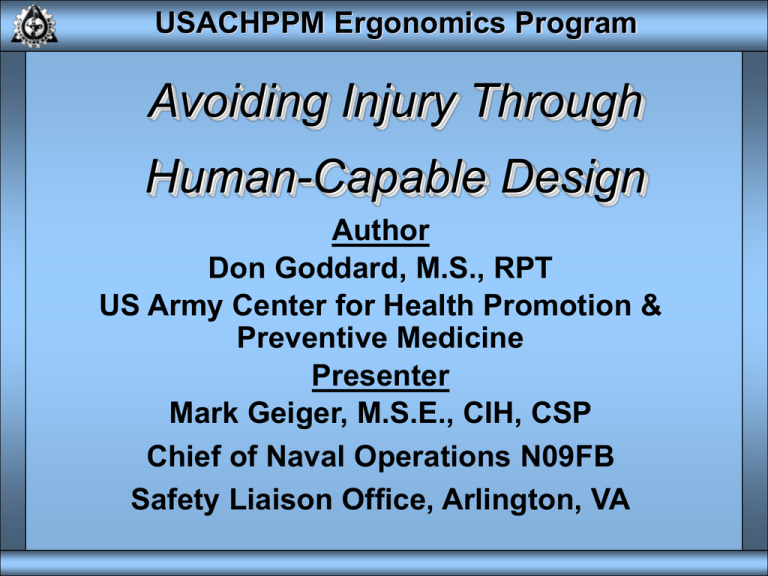Ergonomics and Acquisitions
advertisement

USACHPPM Ergonomics Program Avoiding Injury Through Human-Capable Design Author Don Goddard, M.S., RPT US Army Center for Health Promotion & Preventive Medicine Presenter Mark Geiger, M.S.E., CIH, CSP Chief of Naval Operations N09FB Safety Liaison Office, Arlington, VA Ergonomics and materials handling A key area for acquisition planning Human Systems Integration (HSI) is a part of acquisition requirements (DoD5000.2) Source of many mishaps and occupational illnesses Potential approach to improving safety and reducing manpower ERGONOMICS AFFECTS THE NAVY Other Services Likely to be Similarly Impacted FECA FY99: •Mental Ergonomic injuries and illnesses* Represent the single largest source of claims and costs to the Navy Roughly $90 million annually or one-third of all recent claims If left unchecked, the Navy’s annual cost is Projected to increase to $111 million by FY 2009. * Analyzing the Navy’s Safety Data by CNA, December 2001 •Stress •4% •Exposure •9% •Hearing •4% Ergonomic •37% •Falls •10% •Slips •16% •Vehicle •Accidents •3% •Falling •Objects •2% •All Others •15% What is Human-Capable Design? Creating products that expose users to less mechanical stress in order to: Decrease risk of operator injury Increase operator performance (efficiency) Allow operators to safely and comfortably interact with products longer How is this accomplished now? System Safety reviews: Conducted during design phase of the product development cycle Strive to identify and mitigate injury risks before products are deployed Alternative is expensive retro-fits System Safety and Human Systems Integration (HSI) Both require risk identification System safety has focused on risks to systems Human Systems Integration focus on design for user How is this accomplished now? System Safety reviews tend to rely upon standardized System Safety methods and techniques Tendency to focus on equipment failure Considers risk of injury to human May not optimize design to avoid features that compromise human performance System Safety Methods & Techniques Methods & Techniques Employed Preliminary Hazard Analysis Failure Mode and Effect Analysis Fault Tree Analysis Management Oversight & Risk Tree Energy Trace and Barrier Analysis System Safety Methods & Techniques Struggle to Capture the “Human Side” Analyses are not structured in a way that obligates users to consider long term effects on human operators Tend to be “product-oriented” at the expense of the human system component Deficiencies force users to make assumptions about injury risk System Safety Methods & Techniques Typical Product Specification Product-Oriented Description - Lift capacity: 1.1 tons - Rope capacity: 85 ft - Operating force requirements: 54 lbs Hand Winch “Human-Capability” Questions •Is the user population able to generate 54 lbs? •What is the injury risk for weaker operators? •How does this affect the potential for failure? System Safety Methods & Techniques Limitations of Approach System Safety tools dependent upon assessor’s knowledge of human capabilities Assessment tools don’t provide references that fill knowledge gaps Less knowledgeable assessors must develop inferences about product injury risks that are sometimes based upon faulty assumptions System Safety Methods & Techniques Weakness of Approach People performing System Safety reviews tend to have limited knowledge of human capabilities Commonly used tools do not always fill the gaps in knowledge System Safety Methods & Techniques Evidence of Weakness of Approach Authors concluded that designers often fail to foresee the health risks in the activities associated with the intended use of their products Advocated a task-based risk assessment approach using a hazard list that includes ergonomics Raafat H & Simpson P. Integrating safety during the machine design stage. System Safety Methods & Techniques Evidence of Weakness of Approach Study found an average of 5 Human Factors design problems in each product reviewed Domains included physical & cognitive workload Recommended adhering to a “usercentered” design approach Hutchins SG. Analysis of human factors case studies of complex military systems. System Safety Methods & Techniques Evidence of Weakness of Approach Authors advocate “cradle to grave” integration of safety and design that includes: Implementing Ergonomics Pro- actively Developing Better Contract Specifications Educating Purchasers Christensen WC & Manuele FA. Safety Through Design. National Safety Council, 1999 Common System Design Errors Excessive Muscular Exertion Manual Material Handling Demands Pushing-Pulling Demands Grasp & Finger Force Demands pinch grip Common System Design Errors Example: Excessive MMH Demands Army Mobile Analysis System Original Current 402 lb 275 lb 313 lb 200 lb 100 lb 65 lb 715 lb 640 lb Note: Max Allowable Weight for 4 person team: All Male Team – 305 lbs; Mixed Team – 154 lbs MIL-STD-1472F -- DoD Design Criteria Standard: Human Engineering Common System Design Errors Example: Excessive Pull Demands Drink Can Pulling Force Demands 14 12 10 8 Force Required To Open Can 4.6 lbs 6 4 2 0 2-5 6-10 11-15 16-20 21-30 31-50 51-60 61-70 71-80 Average Maximum Force Capacity (lbs): Female, Male 81-90 Common System Design Errors Excessive Extrinsic Load Load Carriage Head Supported Mass* The head is about the size and weight of a bowling ball Common System Design Errors Example: Excessive Load Carriage Heavy Army Field Infantry Load Soldiers Expected to Carry Heavy Equipment Load Common System Design Errors Example: Excessive Load Carriage Ave FL Ave AML Ave EAML FL1 %BW AML2 %BW EAML3 %BW Rifleman 63 lb 36% 95.7 55% 127.3 71% M240B Ammo Bearer 69 lb 37% 117 lb 62% 144 lb 80% Position 1FL = Fighting Load 2AML = Approach March Load 3EAML = Emergency Approach March Load Many new acquisitions are conceived as “add-ons” to this “baseline” load Common System Design Errors Example: Excessive Load Carriage Military Headgear Design • Wearing heavy gear of long durations may elevate the risk of cervical injury • Asymmetrically distributed load can cause fatigue and increase cervical injury risk Common System Design Errors Excessive Metabolic Demand Regional Fatigue Overusing smaller muscles within a specific region of the body Systemic Fatigue Overusing larger muscles from multiple body regions Activity stresses heart & lungs Heat stress may contribute to overall metabolic load Common System Design Errors Example: Excessive Metabolic Demand Many DoD personnel perform jobs with high cardiopulmonary demands Demands increase further during deployed military operations Have been associated with increased musculoskeletal injury risk (MIR) MIR ↑ 7.6 times for personnel constructing deployed bases Common System Design Errors Dimensional Incompatibility Sizing Human-Machine Couplings Control Points (handles) Other Couplings (i.e., seatpans) Wearables (headgear & clothes) Accesses (doors/hatches & portals) Reaches (arms & legs) Common System Design Errors Example: Human-Machine Coupling Photos courtesy of Gerry Miller Common System Design Errors Example: Human-Machine Coupling Photos courtesy of Gerry Miller Military Vehicle with Retrofitted Ladder •Step-off distance in various military vehicle is in the range of 4 to 6 feet. •The ladder is a retrofit! •Imagine doing this in a vulnerable combat situation with a 80 pound pack! Photo courtesy of Trailormate http://www.trailormate.com Common System Design Errors Example: Human-Machine Coupling This is a first design of what device? Computer Mouse Common System Design Errors Example: Human-Machine Coupling Hand-Tool Size Mismatch Handles get smaller, but hand does not Smaller handles are difficult to use by normal-sized hands Do we need different size operators to use each task or tool? Common System Design Errors Example: Size of Wearables Product Size Mismatch Wrong-sized apparel frustrates users Common System Design Errors Example: Access Dimensions Wrong-sized Opening Head may strike handle while trying to exit vehicle http://www.usabilitymatters.org Common System Design Errors Example: Access Dimensions Problem Inadequate Clearance Pilots Killed Ejecting From F104A F105D “Sample” Cockpit • Cause: Bad Seat Design • Detail: pilot’s knees would not clear the forward canopy edge due to the fact that the parachute placement positioned the pilot too far forward • Solution: The model DQ-7 seat was replaced with a redesigned GQ-H7 seat that allowed clearance Common System Design Errors Example: Poor Workstation Design Excessive Reach Requirement Bike Design Causes Headaches Shortened muscles compress nerve • Cause: Bicycle “Workstation” Design • Detail: Chronic extended neck posturing shortens muscle in back of neck, increases pressure on suboccipital nerve, and may cause headaches & disc disease • Solution: Ride a bicycle that allows upright spinal posture Common System Design Errors Avoided by New Approach springdalebicycle.com/ Why_Recumbant.htm Shortened muscles compress nerve http://www.kreuzotter.de/ Common System Design Errors Example: Poor Workstation Design Excessive Reach Requirement $5 solution Difficult pinning papers located beyond reach envelope http://www.usabilitymatters.org Common System Design Errors Extrinsic Mechanical Energy Exposure Hand Arm Vibration (HAV) Whole Body Vibration (WBV) Jolt •www.osha.gov/.../ hot_work_welding.html Common System Design Errors Example: Excessive HAV Exposure Manual Soil Plate Compactor Exposure Characteristics Acceleration: 7.3 m/s2 Exposure Limit: 120 min/day Compactor Transfers Vibration to Operator’s Hands Mitigation efforts (equipment redesign, equipment substitution, process redesign) unknown – See this afternoon’s presentation by Nancy Estrada Common System Design Errors Example: Excessive WBV Exposure Heavy Construction Equipment Exposure Limits Paved Road: 30 min Gravel Road: 105 min Cross-Country: 410 min Vehicle Transfers WBV Through Body Contact Points Mitigation efforts (equipment redesign, equipment substitution, process redesign) unknown See this afternoon’s presentation by LT Harrer Typical Life Cycle Costs in Acquisition Commit to Human Systems Integration Implement Human Systems Integration efforts throughout the product’s entire lifespan This can be the disposal end 20-30% Procurement 60-70% Operations, Maintenance & Disposal 10% R&D •70% of costs committed in preliminary designs Production & Operations & Support Deployment System Technology Concept Development & Development Refinement Demonstration Requirements for Life-cycle Safety DODI 5000.2 Operation of the Defense Acquisition System May 12, 2003 3.9.2 Sustainment Effective sustainment of weapon systems begins with the design and development of reliable and maintainable systems through the continuous application of a robust systems engineering methodology. As a part of this process, the PM shall employ human factors engineering to design systems that require minimal manpower; provide effective training; can be operated and maintained by users; and are suitable (habitable and safe with minimal environmental and occupational health hazards) and survivable (for both the crew and equipment). Requirements for Life-cycle Safety Practice = Theory DODI 5000.2 Operation of the Defense Acquisition System May 12, 2003 3.9.2 Sustainment Fall protection >5 Ft U.S. Navy Photo by Photographer's Mate 2nd Class Bradley J. Sapp (RELEASED) For more information go to: http://www.cpf.navy.mil/RIMPAC2004/ The PM shall employ human factors engineering to design systems that require minimal manpower; provide effective training; can be operated and maintained by users; and are suitable (habitable and safe with minimal environmental and occupational health hazards) and survivable (for both the crew and equipment). How Can The Process Be Improved? Educate Key Players in Ergonomics Increase acuity of recognition of job demand/worker physical capacity mismatches Improve problem-solving skills relevant to mitigating potential health risks due to mismatches between job demands & worker physical capacity How Can The Process Be Improved? Develop Better Risk Assessment Tools Based on Human Capability and Exposure Tolerance Limits for these Common Problem Areas: Excessive Muscular Exertion Extrinsic External Load Excessive Metabolic Demand Dimensional Incompatibility Extrinsic Mechanical Energy Exposure How Can The Process Be Improved? Develop Better Risk Assessment Tools Design engineers can use them to guide decisions during early product development How Can The Process Be Improved? Stop Buying High-Risk Products Purchase of high-risk products is reduced through awareness education and risk assessment Decision-makers are provided an assessment tool that identifies high risk product characteristics that should be considered before purchase Examples Procurement of Heavy Vehicle Risk Analysis Reveals Following: Vehicle operation exposes personnel to whole body vibration Purchase decision should consider injury risk based upon existing standards Procurement of Heavy Vehicle Vehicle maintenance exposes personnel to ergonomics hazards Purchase decision should apply an assessment tool that considers ergonomics injuries Navy Ergonomics Manual Process Annual Cost Improved Process Annual Cost Annual Cost Difference (Savings) Tool Purchase Price (5 units) Return on investment (10 yr. service life) Cost Savings Break Even Point Facility Maintenance 45.9K 22.7K 22.8K 14.5K No injuries since inception 213K 232 Days TYPICAL AIRCRAFT CARRIER DEEP TANK REFURBISHING OPERATION COST AVOIDANCE ASSOCIATED WITH IMPROVED ACCESS Present Present Proposed Proposed Savings Savings Number Work of entries/ time personnel (hours) Cost ($60/hr) Work time Cost ($60/hr) Work time (hours) Cost ($60/hr) 42 $21.2K 55 $13.3 32 $7.9K 88 Savings $250,000 per shipyard period, $2,500,000 lifecycle System Safety protects USERs Those often unable to influence system design (Also protects the taxpayers) This Identifies risks in prior systems Requires that controls be built into the design Minimizes later work-around Training Protective Not this! equipment Complex procedures Reduces maintenance and disposal costs Resources Service Ergonomics Programs DOD Ergonomics Working http://www.ergoworkinggroup.org/ Group Air Force Occupational and Ergonomics Program http://www.brooks.af.mil/afioh/Health%20Programs/ergonomics_links.htm Crew System Ergonomics Information Analysis Center http://cseriac.flight.wpafb.af.mil/ Service Ergonomics Programs Navy- Acquisition Website www.safetycenter.navy.mil/acquisition http://www.safetycenter.navy.mil/presentations/osh/previe wimages/ergonomics4.gif Ergonomics program OPNAVINST5100.23 Chapter 23 Ergonomics NAVSEAINST 3900.08A Date 20 May 2005 Subject HUMAN SYSTEMS INTEGRATION (HSI) POLICY IN ACQUISITION AND MODERNIZATION Service Ergonomics Programs Army Ergonomics Overview http://www.cs.amedd.army.mil/iso/IntroErgonomics/Default.htm US Army Center for Health Promotion and Preventive Medicine http://chppm-www.apgea.army.mil/dohs/ Health Hazard Assessment Program http://chppm-www.apgea.army.mil/dohs/hha/HHAPocketGuide.pdf Manprint Program http://www.manprint.army.mil/manprint/ •Example of Common Task Design Criteria •www.ccohs.ca/.../ welding/ergonomics.html Field Tools Most are simple Angle measure Scale Gauge for pulling stress •www.jacks.co.nz/measuring_ length__moisture.html Contact Information Don Goddard, M.S., RPT US Army Center for Health Promotion & Preventive Medicine don.goddard@us.army.mil Mark Geiger, M.S.E., CIH, CSP Chief of Naval Operations N09FB Safety Liaison Office, Arlington, VA Mark.Geiger1@navy.mil 703 602-5020






